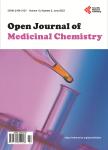Pharmacochemical Aspects of the Evolution from Erythromycin to Neomacrolides, Ketolides and Neoketolides
Pharmacochemical Aspects of the Evolution from Erythromycin to Neomacrolides, Ketolides and Neoketolides作者机构:Department of Therapeutic Chemistry and Organic Chemistry UFR Pharmaceutical and Biological Sciences FHB University Abidjan Cô te d’Ivoire
出 版 物:《Open Journal of Medicinal Chemistry》 (药物化学期刊(英文))
年 卷 期:2020年第10卷第3期
页 面:57-112页
学科分类:081704[工学-应用化学] 07[理学] 08[工学] 0817[工学-化学工程与技术] 070303[理学-有机化学] 0703[理学-化学]
主 题:Pharmacochemistry Erythromycin Neomacrolide Ketolide Neoketolide Structure-Activity Relationships
摘 要:Antibiotic macrolides are experiencing renewed interest in anti-infective therapy since the advent of ketolides. This therapeutic class was introduced in order to broaden the narrow antibacterial spectrum of macrolides and to cope with the emergence of germs resistant to Erythromycin A and its hemisynthetic derivatives or neomacrolides (Clarithromycin, Roxithromycin, Azithromycin, Dirithromycin). From a pharmacochemical point of view, ketolides were first of all obtained by operating chemical modulations on Erythromycin A to obtain the neomacrolides, then, by replacing the neutral sugar (L-cladinose) in C3 by a ketone function coupled with the creation of an oxazolidinone like heterocycle in C11 and C12 in place of the hydroxyls present in these positions (Telithromycin, Cethromycin, Solithromycin). These modulations have enabled the improvement of the chemical stability of ketolides in gastric acid medium and increase their affinity for the ribosomal target, hence the broadening of their spectrum of action towards Gram positive germs including strains resistant to other macrolides and to neomacrolides. Therefore, the objective of this systematic review is to report the various pharmacochemical aspects undertaken since 1952 in the macrolide series based on the structure of Erythromycin A. These aspects will focus on the pharmacomodulations that have led, year after year, to the optimization of stability, the improvement of the pharmacodynamic and pharmacokinetic profile and that have allowed the development of neomacrolides, ketolides and neoketolides, which are today essential in the management of severe bronchopulmonary infections.



